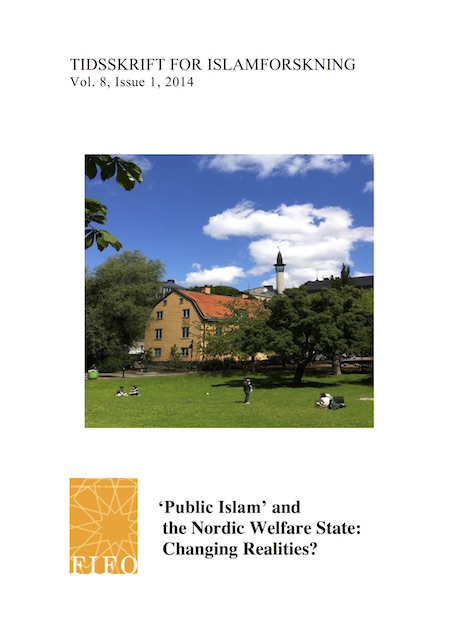Preface
DOI:
https://doi.org/10.7146/tifo.v8i1.25321Abstract
This special issue is the outcome of a generous invitation by the Center for Islamic Studies of Youngstown State University, Youngstown, Ohio, to arrange a seminar on Nordic Islam at Youngstown State and to publish the proceedings in the Center’s journal, Studies in Contemporary Islam. To make the proceedings available to Nordic audiences, the proceedings are also being published in the Tidsskrift for Islamforskning. The seminar was held on 25–26 October 2010, and was highly rewarding. The contributors are grateful for the hospitality they received during their stay in Youngstown. They are also grateful to Professor Rhys Williams, Director of the McNamara Center for the Social Study of Religion at Loyola University Chicago, for contributing to the seminar and the special issue. Rhys Williams’ perspective is that of an experienced researcher of religion in the USA, and represents the logical opposite of the Nordic state model and its way of organizing welfare, civil society, and religion. Dr. Williams’ perspective helps to highlight the specifics of the Nordic context. Last but not least, the contributors wish to thank the editors of the Tidsskrift for Islamforskning.
The fact that this special issue about Islamic institutions and values in the context of the Nordic welfare state is intended for both American and Nordic readers has inspired the framework that introduces the issue. The first three contributions constitute one group, as they each deal with the significance that the two different welfare and civil society models represented by the Nordic countries and the USA may have for the institutionalization of Islam and Muslims’ public presence and values. First, Ulrika Mårtensson provides a historical survey of the Nordic welfare state and its developments, including debates about the impact of neoliberal models and (de)secularization. This survey is followed by Rhys Williams’ contribution on US civil society and its implications for American Muslims, identifying the significant differences between the US and the Nordic welfare and civil society models. The third contribution, by Tuomas Martikainen, is a critical response to two US researchers who unfavorably contrast European ‘religion-hostile’ management of religion and Islam with US ‘religion-friendly’ approaches. Martikainen , with reference to Finland, that globalized neoliberal ‘new public management’ and ‘governance’ models have transformed Finland into a ‘postsecular society’ that is much more accommodating of religion and Islam than the US researchers claim.
The last seven contributions are all concerned with the ‘public’ dimensions of Nordic Islam and with relations between public and Islamic institutions and values. In the Danish context, Mustafa Hussain presents a quantitative study of relations between Muslim and non-Muslim residents in Nørrebro, a part of Copenhagen, the capital, which is often portrayed in the media as segregated and inhabited by ‘not well integrated’ Muslims. Hussain demonstrates that, contrary to media images, Nørrebro’s Muslim inhabitants feel that strong ties bind them to their neighborhood and to non-Muslims, and they trust the municipality and the public institutions, with one important exception, that of the public schools.
From the horizon of the Norwegian capital, Oslo, Oddbjørn Leirvik explores public discourses on Islam and values with reference to national and Muslim identity and interreligious dialogue; Leirvik has personal experience of the latter since its start in 1993. From the Norwegian city of Trondheim, Eli-Anne Vongraven Eriksen and Ulrika Mårtensson chart the evolution of a pan-Islamic organization Muslim Society Trondheim (MST) from a prayer room for university students to the city’s main jami‘ mosque and Muslim public representative. The analytical focus is on dialogue as an instrument of civic integration, applied to the MST’s interactions with the church and the city’s public institutions. A contrasting case is explored in Ulrika Mårtensson’s study of a Norwegian Salafi organization, whose insistence on scriptural commands and gender segregation prevents its members from fully participating in civic organizational activities, which raises questions about value-driven conditions for democratic participation.
In the Swedish context, Johan Cato and Jonas Otterbeck explore circumstances determining Muslims’ political participation through associations and political parties. They show that when Muslims make public claims related to their religion, they are accused of being ‘Islamists’, i.e., mixing religion and politics, which in the Swedish public sphere is a strong discrediting charge that limits the Muslims’ sphere of political action in an undemocratic manner. Next, Anne Sofie Roald discusses multiculturalism’s implications for women in Sweden, focusing on the role of ‘Swedish values’ in Muslims’ public deliberations about the Shari‘a and including the evolution of Muslims’ values from first- to second-generation immigrants. Addressing the question of how Swedish Islamic schools teach ‘national values’ as required by the national curriculum, Jenny Berglund provides an analysis of the value-contents of Islamic religious education based on observation of teaching practices. In the last article, Göran Larsson describes the Swedish state investigation (2009) of the need for a national training program for imams requested by the government as well as by some Muslims. The investigation concluded that there was no need for the state to put such programs in place, and that Muslims must look to the experiences of free churches and other religious communities and find their own ways to educate imams for service in Sweden.
Downloads
Published
How to Cite
Issue
Section
License
Scandinavian Journal of Islamic Studies publish under creative commons license BY-NC-SA.





